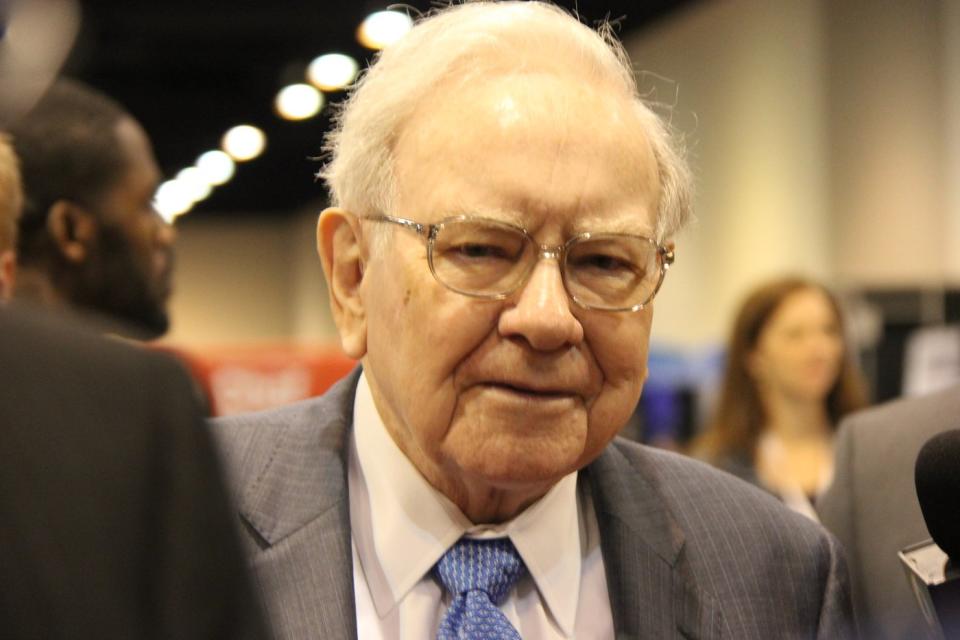Warren Buffett Is Raking In $4.36 Billion in Annual Dividend Income From These 5 Stocks
For nearly 60 years, Berkshire Hathaway (NYSE: BRK.A)(NYSE: BRK.B) CEO Warren Buffett has been dazzling professional and everyday investors with outsize investment returns. Whereas the benchmark S&P 500 has gained more than 34,000%, including dividends paid, since the Oracle of Omaha became CEO, Berkshire Hathaway's Class A shares have appreciated by more than 5,000,000%.
Buffett and his investment team have long relied on brand-name, time-tested, and well-managed businesses to deliver superior returns. But it's Buffett's preference for dividend stocks that might provide one of the biggest boosts to Berkshire's long-term outperformance.
According to a report issued last year by Hartford Funds, in collaboration with Ned Davis Research, dividend stocks have produced an average annual return of 9.18% over a half-century (1973-2022). This compares to a modest 3.95% average annual return for public companies that don't offer a payout.

Companies that regularly share a percentage of their earnings with their investors are almost always time-tested and able to offer transparent long-term growth outlooks. This is why Berkshire Hathaway's $370 billion investment portfolio is packed with dozens of dividend stocks.
But diversification was never big with Buffett or his late right-hand man, Charlie Munger. Although the investment portfolio Buffett and his team oversee is on pace to generate about $6 billion in annual dividend income, a whopping $4.36 billion in combined common- and preferred-stock dividends can be traced to just five companies.
Bank of America: $991.5 million in annual dividend income
Berkshire Hathaway's second-largest holding by market value ($38 billion), Bank of America (NYSE: BAC), is the Buffett's dividend breadwinner. The more than 1 billion shares of BofA Berkshire owns will yield almost $992 million in annual dividend income.
The reason Buffett has long favored financial stocks (especially banks) is because they benefit from disproportionately long periods of U.S. growth. While recessions are a normal and inevitable part of the U.S. economic cycle, they have all been short-lived since the end of World War II.
By comparison, there have been two expansions that surpassed the decade mark. Cyclical bank stocks like Bank of America are able to steadily increase their interest income and fee-generating loan portfolios as the U.S. economy expands.
The other well-defined lure for Bank of America is that it's the most interest-sensitive money-center bank in the United States. This is to say that its net-interest income will increase or decrease more with changes to the prevailing interest rate than with other big banks. The Federal Reserve's aggressive rate-hiking cycle during the past two years has added billions of dollars in net-interest income to Bank of America's bottom line.
Occidental Petroleum: $897.5 million in annual dividend income
The second-biggest dividend payer in the Berkshire Hathaway portfolio might come as a bit of a surprise. Energy stock Occidental Petroleum (NYSE: OXY), which doesn't have a particularly hefty yield, is on pace to provide more than $897 million in aggregate annual income this year.
Based on the roughly 248 million shares of Occidental common stock that Berkshire has acquired since the start of 2022, Buffett's company should collect more than $218 million in dividend income this year. But Berkshire also owns $8.49 billion in preferred stock in Occidental that yields 8% annually ($679.2 million a year). This was originally a $10 billion stake, but Occidental has since redeemed $1.51 billion of the issue.
The reason Occidental Petroleum is so attractive to Buffett and his crew likely is because it's more linked than other integrated oil and gas companies to the spot price of crude oil. It generates the bulk of its sales from its drilling operations.
More than three years of reduced capital investment from major energy companies during the pandemic has constrained global oil supply and provided a lift to the spot price of crude. If prices remain elevated, Occidental should enjoy an outsized benefit.

Apple: $869.3 million in annual dividend income
It's probably no surprise that Berkshire Hathaway's largest position by market value ($154.7 billion), tech stock Apple (NASDAQ: AAPL), is one of the biggest providers of dividend income. Even after Buffett and his aides pared down Berkshire's Apple stake by some 10 million shares during the fourth quarter, the nearly 905.6 million shares still held will generate about $869 million in annual dividend income.
The beauty of Apple stock has long been its exceptional branding, strong customer loyalty, and top-tier innovation. Though it remains the domestic leader in smartphone market share, much of the future growth is expected to come from its shift to services.
CEO Tim Cook is overseeing a steady push toward subscriptions, which should smooth out the sales fluctuations that occur just before major iPhone upgrade cycles, as well as keep customers loyal to Apple's ecosystem of products and services.
But if you ask Buffett, his favorite thing about Apple might be its market-leading share repurchase program. Since initiating a buyback program in 2013, it has repurchased almost $651 billion worth of its common stock. Not only is this providing a boost to Apple's earnings per share, but it is also steadily increasing Berkshire Hathaway's ownership stake in the company without having to do a thing.
Chevron: $822.1 million in annual dividend income
Oil stocks are historically known for their robust payouts. In addition to collecting over $897 million from Occidental Petroleum, Buffett's company should be on the receiving end of more than $822 million in annual payouts from Chevron (NYSE: CVX). The dividend hike Chevron announced in February marked the 37th consecutive year it has lifted its base annual payout.
Even though Chevron and Occidental are subject to the same macro forces, Chevron's outlook is a bit different than Occidental. That's because Chevron's revenue channels are skewed more toward its non-drilling assets, such as pipelines, refineries, and chemical plants. These midstream and downstream assets produce highly predictable cash flow in virtually any economy.
Chevron also has what can be considered one of the best balance sheets among major energy companies. It closed out 2023 with a net debt ratio of just 7.3%. Given its storied history of generating positive cash flow from its operations, Chevron has the financial flexibility to make big acquisitions and return a lot of money to its shareholders via dividends and buybacks.
Coca-Cola: $776 million in annual dividend income
The fifth dividend stock that -- along with Bank of America, Occidental, Apple, and Chevron -- is helping Warren Buffett and his team oversee the collection of $4.36 billion in annual dividend income for Berkshire Hathaway is consumer staples titan Coca-Cola (NYSE: KO).
Coca-Cola has been a continuous holding for Berkshire Hathaway since 1988. Because the cost basis on the 400 million shares held by Berkshire is so low (about $3.2475 per share), Coke's $1.94-per-share annual payout equates to a nearly 60% yield on cost for Buffett's company.
What's made Coca-Cola stock such a wonderful investment for decades is its geographic diversity. It has operations in every country worldwide with the exception of North Korea, Cuba, and Russia. This means it's able to take advantage of faster organic growth in emerging markets, while still generating highly predictable operating cash flow in developed countries. It also has more than two dozen brands that generate in excess of $1 billion in annual sales.
Top-shelf marketing is another reason Coca-Cola has been able to increase its annual dividend in each of the past 62 years. It's leaning on digital media channels and artificial intelligence (AI) to tailor advertisements for younger audiences, and can rely on its well-known brand ambassadors and rich history to connect with more-mature consumers.
Should you invest $1,000 in Bank of America right now?
Before you buy stock in Bank of America, consider this:
The Motley Fool Stock Advisor analyst team just identified what they believe are the 10 best stocks for investors to buy now… and Bank of America wasn’t one of them. The 10 stocks that made the cut could produce monster returns in the coming years.
Stock Advisor provides investors with an easy-to-follow blueprint for success, including guidance on building a portfolio, regular updates from analysts, and two new stock picks each month. The Stock Advisor service has more than tripled the return of S&P 500 since 2002*.
*Stock Advisor returns as of March 25, 2024
Bank of America is an advertising partner of The Ascent, a Motley Fool company. Sean Williams has positions in Bank of America. The Motley Fool has positions in and recommends Apple, Bank of America, Berkshire Hathaway, and Chevron. The Motley Fool recommends Occidental Petroleum. The Motley Fool has a disclosure policy.
Warren Buffett Is Raking In $4.36 Billion in Annual Dividend Income From These 5 Stocks was originally published by The Motley Fool
